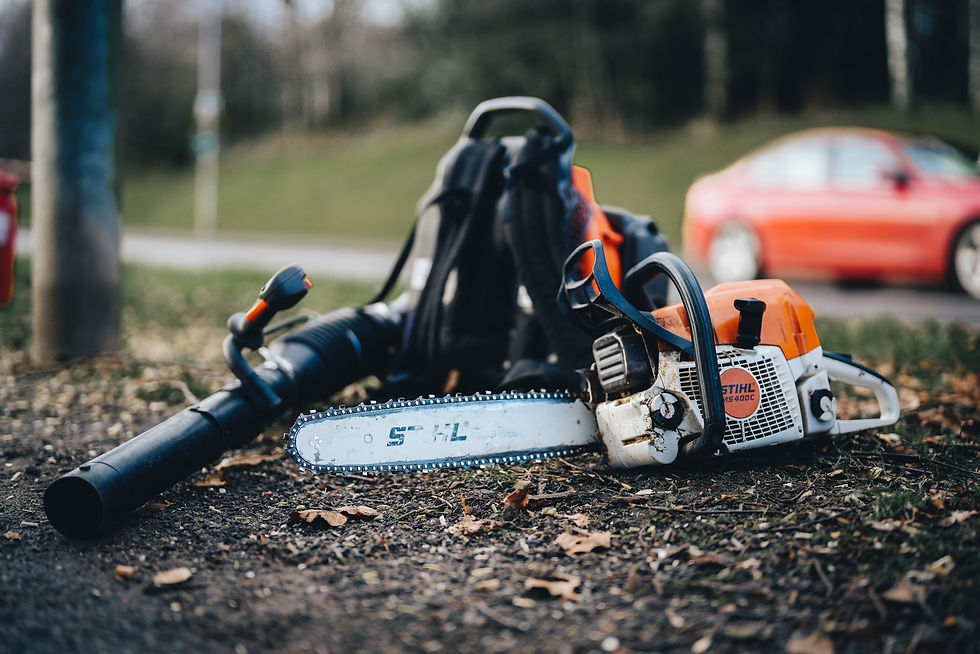Is My Tree Dying?
- Neil Foote

- Jun 2, 2022
- 5 min read
In this blog we're going to have a look at some ways that you can tell if your trees health is declining, and some ways you could treat it.
Tree's are not only one of our biggest assets with regards to Carbon removal and oxygen production, but are aesthetically pleasing to us. There has been much research recently looking at treating mental health and well being problems by getting folk out into nature. one of the best bits of our jobs as Arborist's is meeting clients that have a huge sentimental attachment to a tree in their garden and helping them to look after their tree.
On the flip side a tree that is coming to the end of it's life can usually spell danger to people and property, so a lot of the time there has to be a plan of action in place weighing up the benefits of keeping and treating a tree, pruning or outright removal.
So here's a few signs that your tree may be dying, along with some care advice;
Leafs and Needles
Leafs and needles are the primary way a tree makes sugar for energy. The tree takes CO2 from the Air via the leaves and water/nutrients from its roots. Chloroplasts in the tree's leaves absorb sunlight which allows them to convert the CO2 and H20 into O2, which is obviously essential to all life, and C6H1206 (Glucose) which is how the tree sustains it's growth.

Have a look at your tree, if the leaves are late to come out in spring, or early to shed in the Autumn then your tree is under stress. If the tree starts losing leaves in Summer, or the colour of the leaves changes then don't ignore it. This could be to do with conservation of energy or could be Fungal, Bacterial or invertebrate Pathogen such as Silver leaf fungis, phytophththoria (root rot), Hymenoscyphus Fraxineus (Ash Die Back). In Conifers "browning" of needles can be as a result of Tip Blight such as Diplodia.
Leaves that appear bright green could signify problems with nutrient deficiency such as lack of Nitrogen.
2. Twigs and Branches
Keep a regular eye on the upper Canopy of your tree, and also on your lawn. If you suddenly see more twigs on the ground then this is usually a sign that somethings wrong. Similarly any branches devoid of leaves, as above, can be a cause for concern. A very simple method to do if you're worried about twigs or branches is a simple "scratch test"
The Ring of sap wood directly under the outer bark is called the Cambium layer, and this is the "living" part of a tree that transports water from the roots, up the trunk, limbs and twigs to the leaves for photosynthesis to occur. If you're unsure as to the health of a limb or twig, you can make a tiny (please note tiny) cut into the Cambium layer, if this layer is bright green then this part of the tree is still alive. If the scratch is brown, this indicates that the branch is dead and die back has occured.
3. Bracket Fungi

When it comes to Tree's and Fungi, the relationship between the two is complicated to say the least. There are 3 main groupings of fungi where trees are concerned;
Saprophytic Fungi. These are responsible for the decomposition of already dead wood, and don't typically kill the tree, as the tree was already dead before the fruiting body of the mushroom is visible. These Fungi are rarely a threat to your trees, and if they weren't present then the woodlands would be filled with timber that hadn't been broken down to mulch, and eventually soil!
Parasitic. These fungi find a way into the tree via damage to the bark and badly pruned limbs. Once inside the tree they will start to break down the heart wood of the tree, causing brown rot and eventually structural failure. By the time you see these fungi as their fruiting "brackets" on the bark, unfortunately the damage has been done and the Fungi is trying to spread it's spores for reproduction.
Mycorrhizal Fungi. These fungi are beneficial to the tree. The Hyphae, thin thread like structures that are actually the majority of the fungi under the ground, attach themselves to the roots of trees. They then spread out and increase the surface area of the tree roots, the really amazing part of this symbiosis is that the Fungi allows the tree to draw more water into the roots, and in return the Fungi receives a small amount of Glucose produced by the tree during photosynthesis!
If you see Bracket fungi on your tree it might not always be bad news, however it's worth getting a tree professional out to have a look.
4. Tree Bark
As discussed above, the bark is the outer barrier protecting the sap wood, and stopping infection getting in. Unlike us, tree's never heal, when the bark layer is damaged, a tree has no way to regenerate new cells. Instead they "compartmentalize" the infected area and try to stop pathogens from spreading. Damage to bark can be done in many ways, from human and mechanical to Deer and Rabbit grazing. It's sometimes the case that trees that have not been completely "ringed" (when the circumference of a tree's Cambium layer is completely removed) can make a recovery through compartmentalizing.
Keep an eye out for any damage to the outer bark, including discoloration. Poorly pruned trees can suffer from "Canker" infections. This happens when a branch or twig is cut and fungi or bacteria can get into the wood. Cankers can show up as cracks, fissures, light or dark coloured spots or "swellings" under the bark. Canker is notoriously hard to treat as further pruning can open up more wounds to the Pathogens. At this time of the year (June) keep an eye out for wooly Aphids on your fruit trees, now is the perfect time to treat them.
5. Roots
Around 50% of tree root problems we get called out to are predominantly down to poor site choice for the tree. Trees planted to close to foundations, roads and paths can cause structural damage, heave and cracking of the tarmac so if you're going to plant a tree, think about whats the tree roots can affect in the local vicinity.
Compacted Soil is a real issue in urban areas. Tree's that are planted too close to where there is significant foot fall, whether in a garden or next to a path may well suffer from this condition. Compaction happens over time due to the soil being repeatedly compressed. This removes any "pores" in the soil in which water and nutrients would usually reside, this will result in a loss/lack of leaves, leaves budding late or appearing smaller than usual and branch dieback.
Girdling Roots occur when the lateral roots (roots growing out to the side of the tree) begin to "choke" the trunk, stopping nutrients and water traveling throughout the tree. These roots can be removed, but you'll need an Arborist to inspect prior to any work being done. Removing roots from a tree should never be attempted by someone that isn't qualified, as it can cause the tree to become unstable.
Sometimes when you buy trees from a nursery the tree's roots will be growing in a circle around the pot, be sure to free these roots prior to planting it in your garden.
6. Rot
Surface rot is an easy thing to spot on the exterior of the tree, and will generally present itself in old wounds and poorly pruned branches. As discussed previously trees don't heal themselves, so once rot appears the chances are it's going to spread through a tree until its either stopped by compartmentalization or causes structural damage. if you're unsure how bad the rot is, best get a tree surgeon to have a look.

.png)






Comments